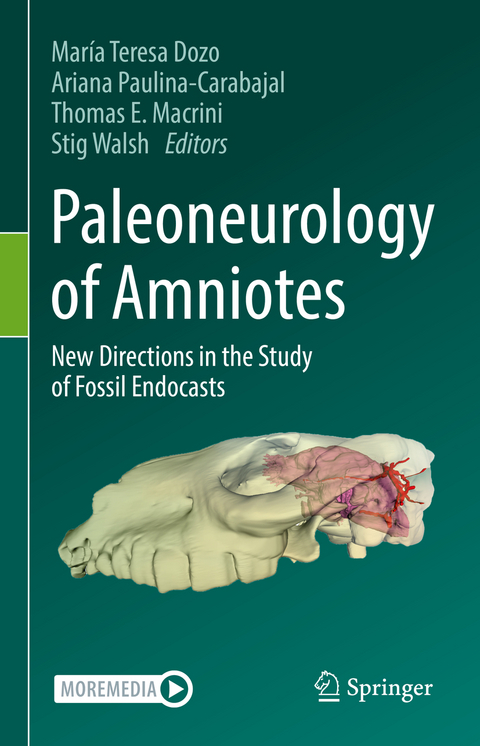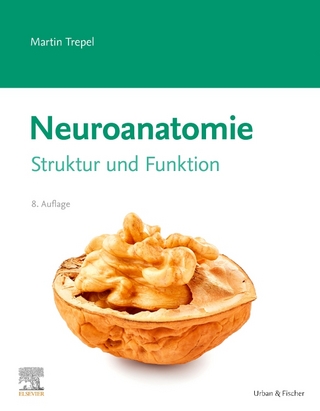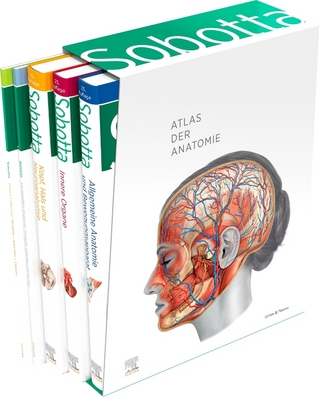
Paleoneurology of Amniotes
Springer International Publishing (Verlag)
978-3-031-13982-6 (ISBN)
This book presents a detailed examination of the current state of knowledge in the field of paleoneurology in the main amniote groups (reptiles, birds and mammals), and advances resulting from new non-invasive technologies. The study of fossil endocasts is an area of considerable current interest, and has long been central to our understanding of the evolution of the brain, development of senses and behavioral adaptations in diverse vertebrate groups and across vertebrates as a whole. Recent advances in non-invasive imaging have significantly increased the number of fossil taxa for which brain morphology is known, and it may now be possible to quantitatively analyze the relative size of brain regions.
Providing a general overview of current perspectives and problems in evolutionary neuroanatomy, this book is intended for a wide range of readers, including undergraduate and graduate students, teachers, and anyone with a special interest in paleoneurology. It isalso useful as supplementary reading for courses in digital anatomy, vertebrate comparative anatomy, computed morphometrics, paleontology, neurology and radiology as well as evolution programs
Maria Teresa Dozo holds a PhD in Natural Sciences from the Universidad de La Plata, and is a Researcher at CONICET, Argentina. Her research focuses on brain evolution of Cenozoic continental mammals of South America, conducting studies of the endocranial spaces in order to understand their neuromorphologies in the systematic, paleobiological and evolutionary context. Her research also includes general studies on Oligocene and Miocene mammals and palaeoenvironments from Central Patagonia to understand the evolutionary history of extinct South American mammals.Dr. Ariana Paulina-Carabajal is a dinosaur paleontologist at the Instituto de Investigaciones en Biodiversidad y Medioambiente (INIBIOMA), Argentina. She holds a PhD in Natural Sciences from Universidad Nacional de La Plata. Her paleoneurology studies center on the braincase and endocranial morphology of dinosaurs and other extinct reptiles to understand the paleobiological implications of certain anatomical regions as well as their impact on the evolution of the group. She has been a member of the scientific board of directors of The Jurassic Foundation since 2012, and the Director of the Museo Paleontologico Bariloche since 2018.Thomas E. Macrini holds a Ph.D. in Geological Sciences from The University of Texas at Austin and was a Postdoctoral Researcher at the American Museum of Natural History in New York. He is currently the Department Chair and Associate Professor of Biological Sciences at St. Mary's University. His research focuses on the evolution of the brain and sensory structures in mammals utilizing high-resolution X-ray computed tomography and traditional histological serial sections to study the endocranial cavity, internal nasal cavity skeleton (turbinals) and associated epithelia, and inner ear of fossil and extant mammals. This research has laid the groundwork for the incorporation of anatomical characters from these regions of the mammalian skull into phylogenetic analyses. Stig Walsh is a Senior Curator of Vertebrate Palaeobiology at the National Museum of Scotland, in the United Kingdom. His interests include neurosensory evolution in archosauromorph reptiles as well as overarching evolutionary questions concerning the evolution of the brain and senses across all vertebrate clades. He uses CT methods to investigate external brain shape and has published both descriptive and quantitative experimental work, as well as reviews of the field of palaeoneurology.
PART 1: FOSSIL ENDOCASTS IN REPTILES AND BIRDS.- Chapter 1 - Onto land and back into water: basal diapsids and marine reptiles.- Chapter 2 - Sauropterygia and Ichthyopterygia: Paleoneurology of secondarily aquatic reptiles .- Chapter 3 - Contrasting brains and bones: implications for turtle paleoneurology .- Chapter 4 - Approaches to the Paleoneurology of Lepidosauromorpha.-Chapter 5 - Paleoneuroanatomy of Triassic archosauriforms and pseudosuchians .- Chapter 6 - Paleoneurology of Crocodylomorpha .- Chapter 7 - Neurosensory evolution in the pterosaurs.- Chapter 8 - Paleoneurology of dinosaur endocasts: past, present, and future research.- Chapter 9 - The evolution of bird brain .- PART 2: FOSSIL ENDOCASTS IN MAMMALS.- Chapter 10 - Paleoneurology of stem and basal Mammalia.- Chapter 11 - Evolution of the brain and sensory structures in monotremes/Evolution of the brain and sensory structures in marsupials.-Chapter 12 - Early evolution of the brain in Primates and their close kin.- Chapter 13 - The brain of condylarthra and extinct Cetartiodactyla.- Chapter 14 - Sirenia fossil endocranial casts: history and evolution.- Chapter 15 - Paleoneurology of the Proboscidea (Mammalia, Afrotheria): insight from the brain endocast, bony labyrinth and infraorbital canal.- Chapter 16 - North American and South American Fossil Rodents: Cranial endocasts of extinct rodents and brain evolution.- Chapter 17 - Parallel patterns in carnivore brain evolution/South American Fossil Carnivorans: Auditory Region of Ursidae and Cranial Endocast of Procyonidae.- Chapter 18 - The Cranial Endocast and Inner Ear Anatomy of Extinct Cingulates.- Chapter 19 - The endocranial cavities of Folivora (Mammalia, Xenarthra): insights from the brain cavity, bony labyrinth and cranial sinuses.- Chapter 20 - Cranial Endocasts and Inner Ear of Notostylopidae and Typotheria/Endocranial Morphologyof Toxodontians (Mammalia, Notoungulata) and Brain Evolution in Paleogene Notoungulates.- Chapter 21 - Digital and Natural Cranial Endocasts of Macraucheniidae (Mammalia, Litopterna): Brain and Frontal Sinuses.
| Erscheinungsdatum | 24.11.2022 |
|---|---|
| Zusatzinfo | XX, 840 p. 171 illus., 123 illus. in color. |
| Verlagsort | Cham |
| Sprache | englisch |
| Maße | 155 x 235 mm |
| Gewicht | 1448 g |
| Themenwelt | Studium ► 1. Studienabschnitt (Vorklinik) ► Anatomie / Neuroanatomie |
| Naturwissenschaften ► Biologie ► Evolution | |
| Naturwissenschaften ► Biologie ► Zoologie | |
| Naturwissenschaften ► Geowissenschaften ► Mineralogie / Paläontologie | |
| Schlagworte | brain evolution • Computed tomography • Cranial Pneumaticity • dinossaurs brain • Encephalization quotient • endocast • fossils • Inner Ear • Sensory evolution |
| ISBN-10 | 3-031-13982-8 / 3031139828 |
| ISBN-13 | 978-3-031-13982-6 / 9783031139826 |
| Zustand | Neuware |
| Informationen gemäß Produktsicherheitsverordnung (GPSR) | |
| Haben Sie eine Frage zum Produkt? |
aus dem Bereich


